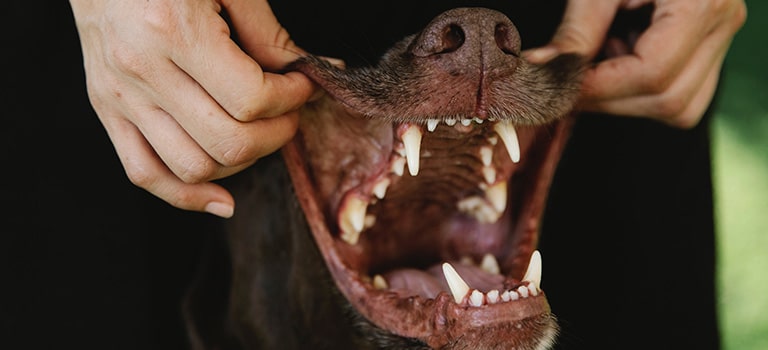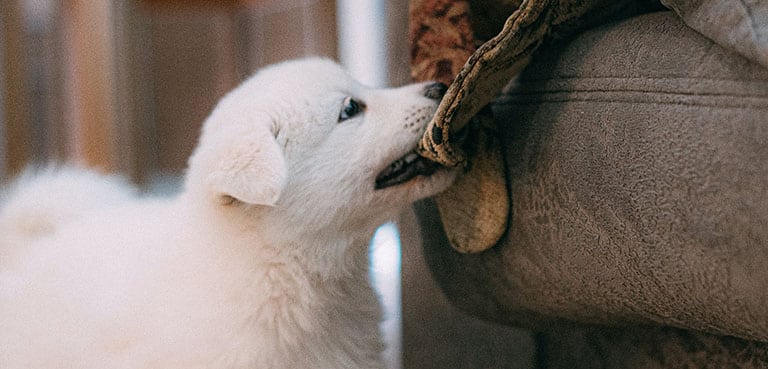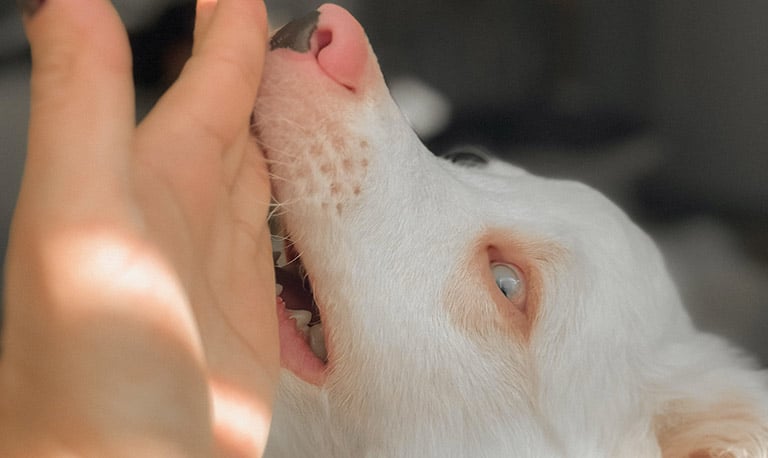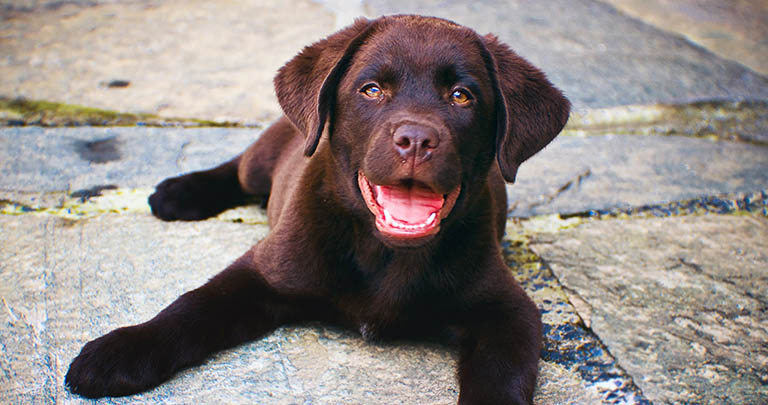The teething phase in puppies can be quite demanding. With their heightened urge to chew on everything and an increase in nipping behavior, both your home and hands may undergo some noticeable wear and tear.
Understanding the timeline of puppy teeth development, recognizing teething symptoms and implementing effective strategies to manage the transition to adult teeth are crucial aspects of responsible puppy care. Use the practical tips and insightful knowledge from this blog to help comfort and provide relief for your puppy as they go through this uncomfortable stage.
Timeline of Puppy Teeth
Puppies are initially born without visible teeth. When puppies are 2-4 weeks old, their baby teeth start emerging through their gums. By weeks five and six, all 28 baby teeth should have fully grown in. The time period between week 12 and week 16 marks when puppies typically transition to their human homes. It is during this time that you may begin to discover small, rice-sized teeth around your house as their first set of teeth begin to shed. It is advisable to schedule a vet appointment during this phase for a thorough checkup to make sure everything is going as it should.
Around six months of age or later, puppies should have shed all their baby teeth, revealing a complete set of 42 adult teeth. If any baby teeth persist beyond this timeframe, it is crucial to contact your veterinarian promptly for necessary removal. To learn more about the timeline of puppy teeth click here.

Puppy Teething Symptoms
Identifying a teething puppy is not difficult. When they are in the process of losing their initial set of teeth, you’ll notice an increase in chewing and/or nipping behaviors. Furniture and shoes may become targets for their chewing and you might observe more frequent nipping during play. Other indicators include excessive drooling, red or swollen gums and a mild fever. The presence of small blood spots on your dog’s toys is common and not a cause for concern. It simply indicates that their teeth are loosening due to vigorous chewing.
During teething, your young furry friend may eat at a slower pace due to discomfort. They may even hesitate to eat their meals. Additionally, they may cry or whine due to the pain associated with teething.

When to Call your Vet
If you observe your puppy experiencing difficulty while eating, such as dropping food from their mouth or displaying a lack of interest in their meals, then it’s essential to contact your veterinarian promptly. Other concerning signs include persistent rubbing at the mouth or a foul odor coming from it. Seeking professional advice is crucial to address any potential issues related to the process of losing teeth.
Certain dog breeds are more susceptible to challenges during the transition from their first set of teeth. For instance, toy breeds often face issues like double teeth, where retained baby teeth can hinder the arrival of adult teeth. This obstruction may lead to a swollen or tender gum area. In such cases, your veterinarian may recommend tooth removal to facilitate the proper eruption of the adult teeth.
How to Help Manage The Transition to Adult Teeth
Chews
To alleviate the discomfort of teething in your young dog, it’s important to provide an array of suitable chew toys. These toys not only offer relief during the teething process but also serve as a safe and healthy outlet for chewing behaviors. When selecting chew toys, ensure they are appropriate for your puppy’s size, weight and chewing style. For example, do not give a husky puppy a chew toy that is meant for a yorkie. Steer clear of plush toys that can easily be torn into small, ingestible pieces.
Opt for chew toys crafted from firm, natural rubber that features textured surfaces and knobs. The robust nature of natural rubber makes these toys resistant to breakage from sharp puppy teeth. The textures and knobs on the surface of the toys serve to massage your young dog’s gums and teeth, providing comfort and relief from teething discomfort. Consider a variety of options, such as hedgehog balls, teething rings and toys with different textures (ranging from hard to soft).
Chewing not only addresses teething woes but also functions as an outlet for stress and anxiety in young dogs. By offering a diverse selection of appropriate chew toys, you can effectively comfort and occupy your baby canine while promoting their oral health. To learn more about which chews are great for teething puppies read here.

Frozen Options
Elevate your puppy’s chewing relief by placing their chew toys or fruits and vegetables in the freezer. As new adult teeth emerge, puppies may experience gum inflammation. Frozen chew toys or fruits and vegetables can be effective in numbing their mouths and alleviating that pain. Opt for rubber puppy chew toys when freezing, as they remain pliable and won’t freeze solid. Choose fruits and vegetables that are safe for your furry friend to consume like strawberries, carrots, bananas and apple slices. To know which foods are safe for your young dog to consume, read this blog.
Alternatively, consider soaking a dish towel or washcloth in water and then freezing it. This cool cloth not only provides numbing relief for your puppy’s gums but also offers a softer chewing texture if that is what your young dog desires that day. You can alter between harder and softer surfaces based on your puppy’s needs and tailor their chewing experience to provide the best comfort and relief.

Chamomile
Harness the ancient medicinal benefits of chamomile to help your puppy through their teething process. This herb is renowned for its calming effects but it also provides healing properties, pain relief and immune-boosting capabilities. Introduce these therapeutic qualities to your young canine by preparing a bowl of chamomile tea. Prior to serving, ensure the tea is fully cooled to a safe temperature for your young furry friend. They’ll eagerly lap it up, similar to how they drink water. If your puppy shows hesitation, consider enhancing the appeal by adding a touch of low-sodium chicken broth.
Puppy Proofing Home
Puppy proofing your home during the teething phase is key to ensuring your house is not destroyed. Begin by gating off rooms that you don’t want your young dog accessing unsupervised. Conceal wires and chords to prevent the risk of electrical shock. Safeguard items prone to puppy chewing, such as magazines and shoes, by placing them out of reach or behind secure doors. Additionally, eliminate potential hazards like toxic plants and food by moving plants out of reach and keeping food off kitchen counters. Taking these precautions can help maintain a safe environment for baby canine and protect your house.
Training to Stop Inappropriate Nipping and Chewing
To address increased teeth-related nipping behaviors in your puppy, swiftly respond if they target any part of your body, especially fingers or toes. Make a sudden, loud sound like “No!” or “Ah!” to startle them and convey that such behavior is unacceptable. Use positive reinforcement when the puppy listens by offering praise or a puppy chew treat when they stop nipping. If your initial command doesn’t yield results, consider a brief timeout in the crate to help your puppy settle down. Apply the same positive reinforcement strategy if you catch your young dog chewing on shoes, furniture or other household items.
You can use a chewing deterrent spray on objects your dog tends to target if they continue in their bad behaviors. These training repellents often contain bitter flavors that help to discourage inappropriate chewing actions.

Making the Transition Easy
As devoted pet owners, providing help to your puppy in managing this transition from baby teeth to adult teeth is important. By following the guidelines outlined in this blog, from puppy-proofing your living space to employing effective teething management techniques, you can foster a comfortable and secure environment for your young furry friend.
Remember, each puppy is unique, so observing their individual needs and preferences can help guide you in tailoring the best strategies to provide relief and a positive teething experience. By taking care of them during this transitional phase you are not only providing for their oral well-being but also strengthening the bond with your puppy.



